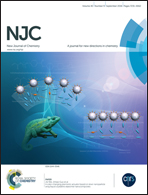What use for polysilsesquioxane lithium salts in lithium batteries?†
Abstract
Aryl-containing lithium perfluorosulfonates form unquestionably a family of salts having fairly good electrochemical performances, especially high cation transference numbers. Here, this family was extended to polysilsesquioxanes in which every silicon atom bears one lithium perfluorosulfonate group, via a sol–gel synthesis involving an original organotrialkoxysilane salt precursor. Despite their high molecular weights, these macro polyanions were found to be highly soluble in polar solvents such as acetonitrile or ethanol. NMR spectroscopy and SEC analysis were consistent with high molecular weight species and a random arrangement of cyclic and/or branched structures. These salts featured a wide electrochemical stability window up to 4 V in acetonitrile solution, while PFG NMR spectroscopy disclosed that the self diffusion coefficient of the macro polyanion decreased significantly with respect to a parent monomer salt chosen as a reference. The potential of high molecular weight polysilsesquioxane salts as lithium source nanofillers in liquid and polymer electrolytes was then discussed in light of the calculated lithium cation transference number.


 Please wait while we load your content...
Please wait while we load your content...